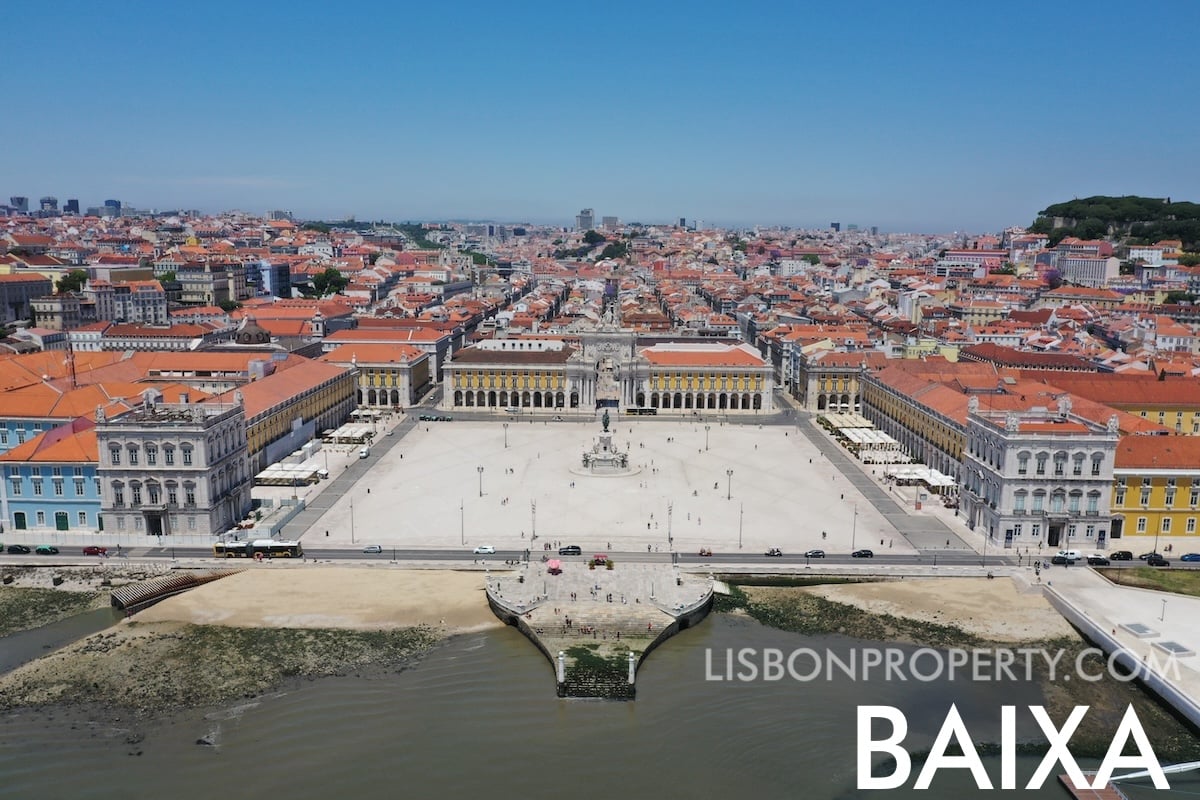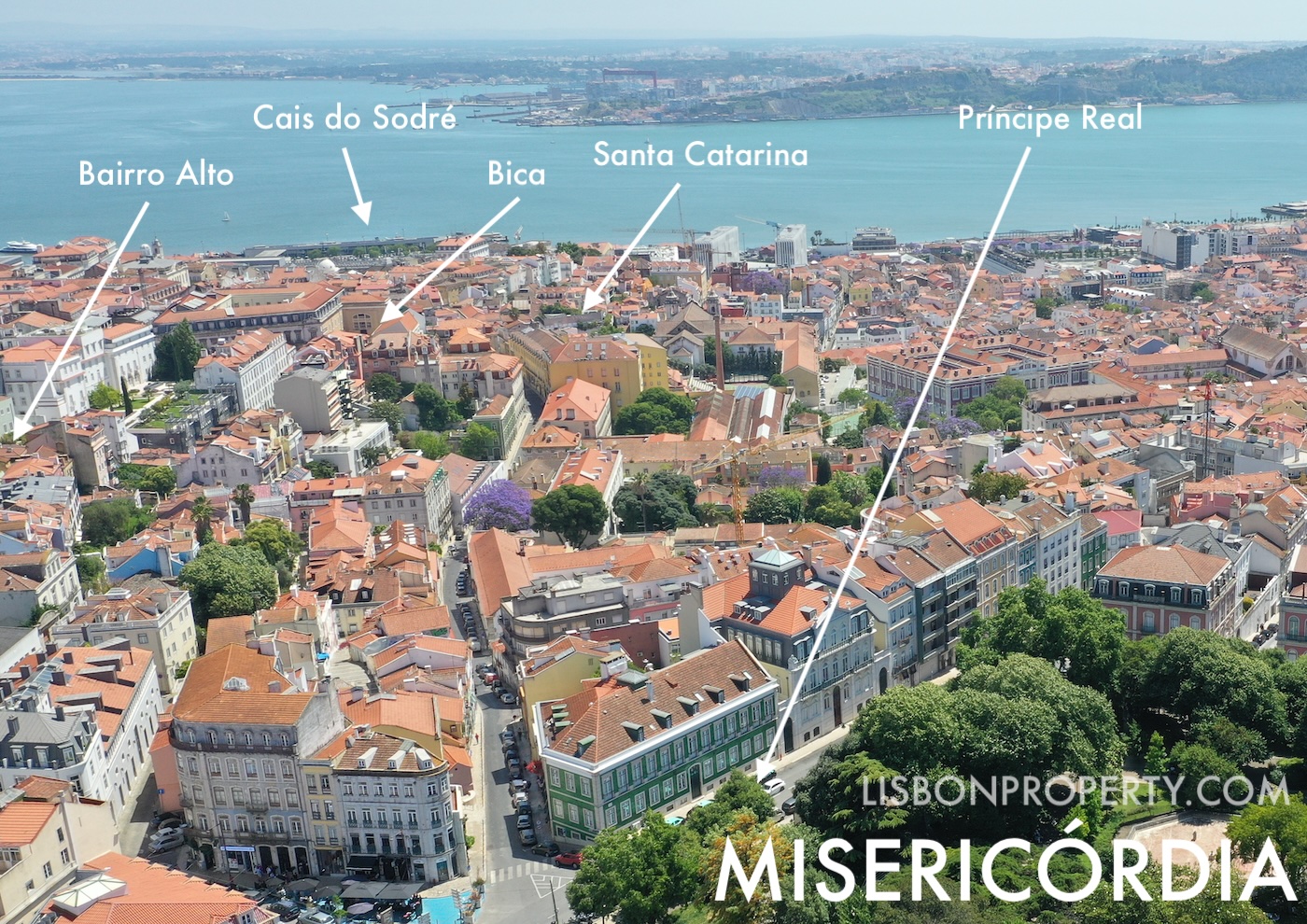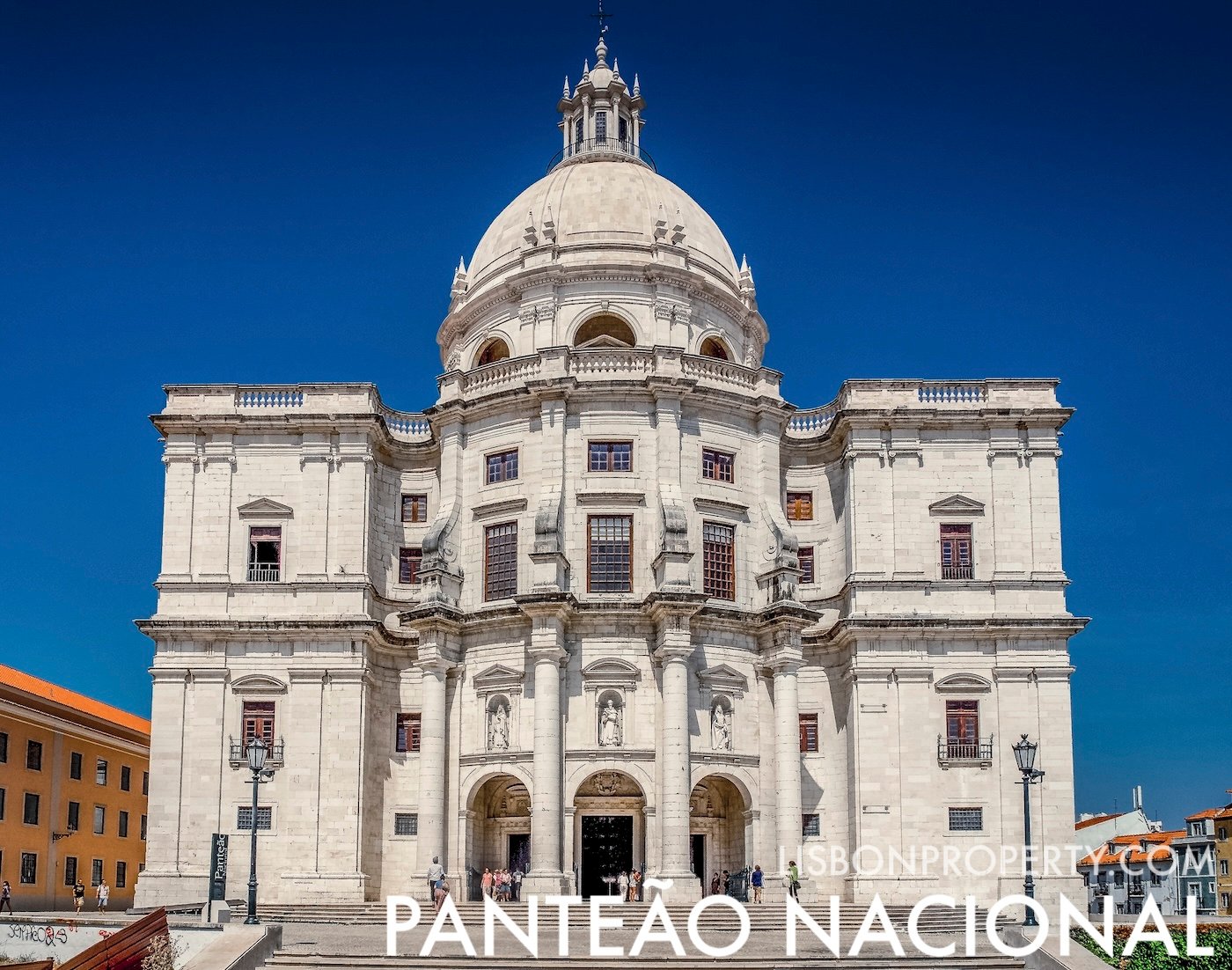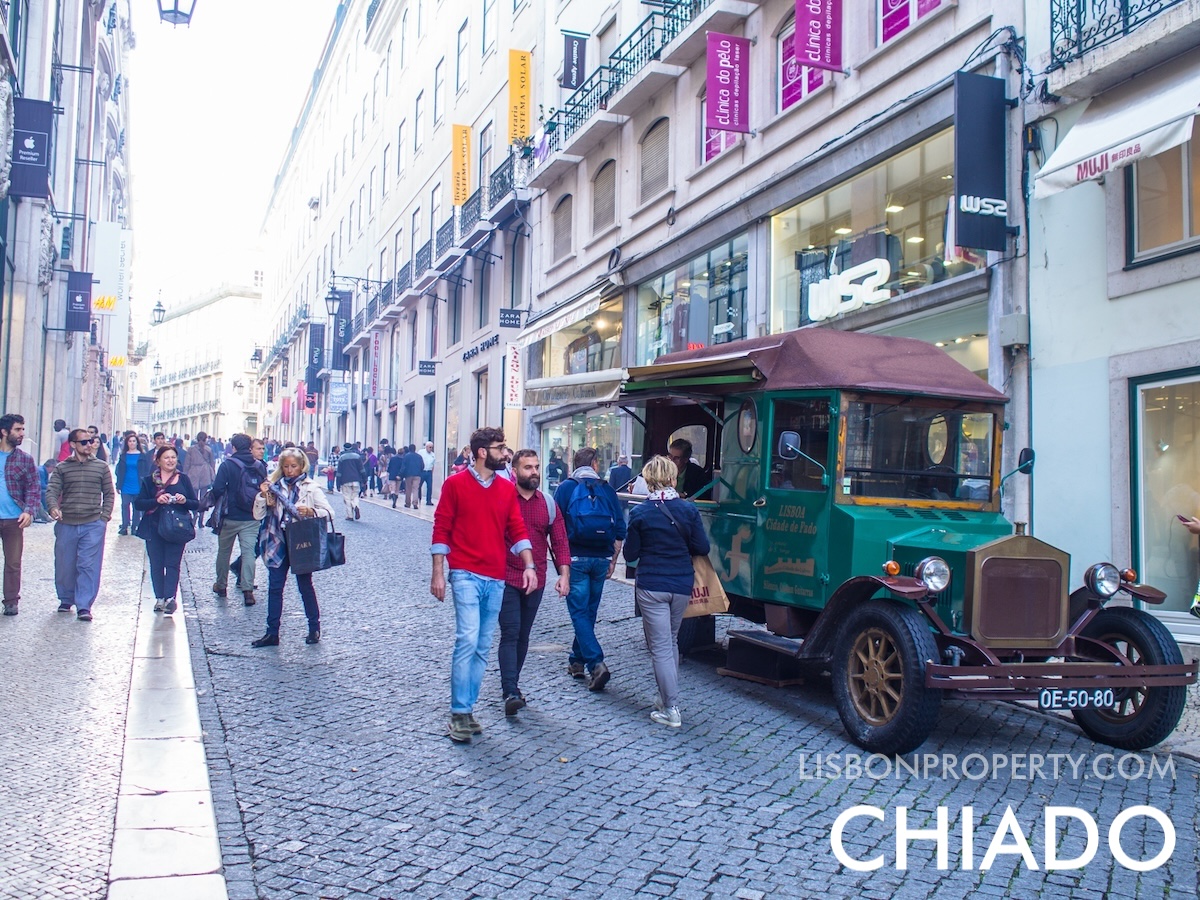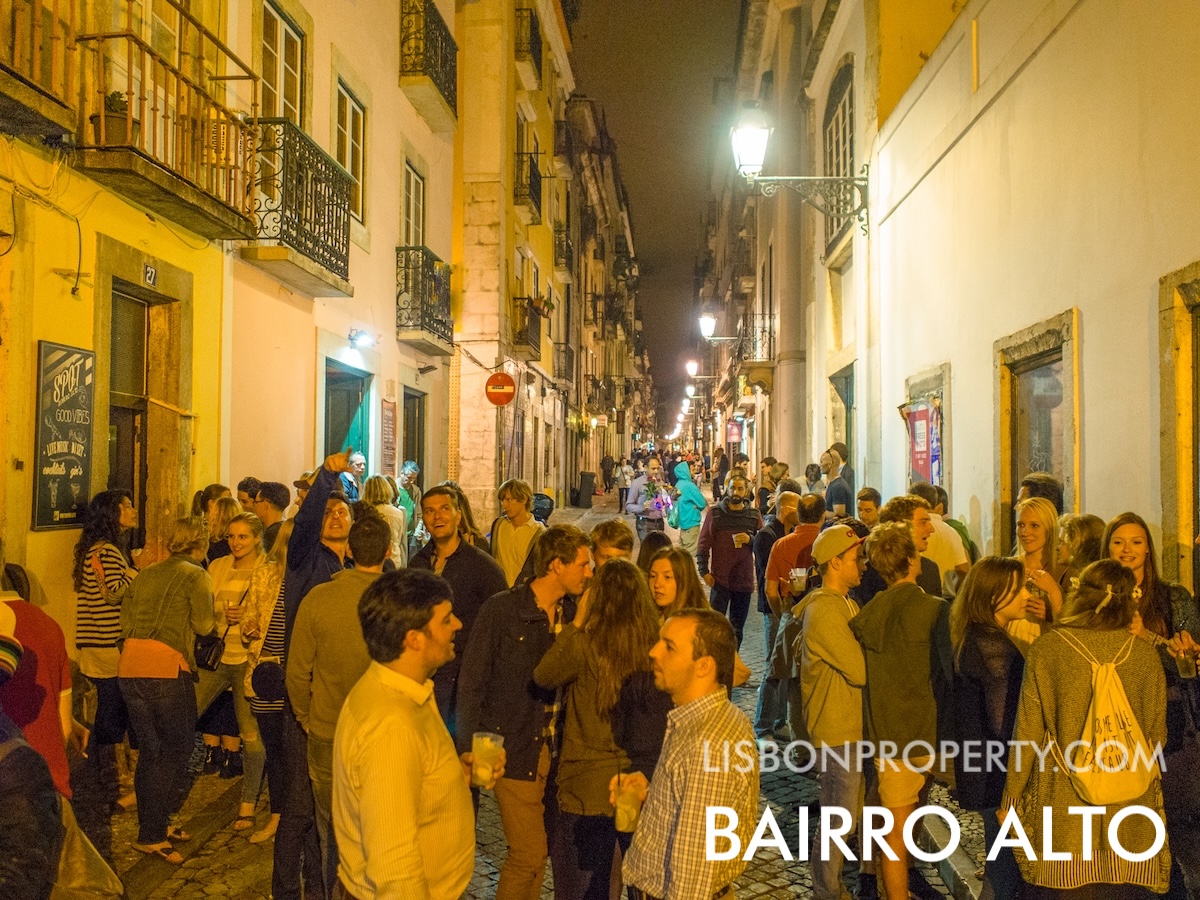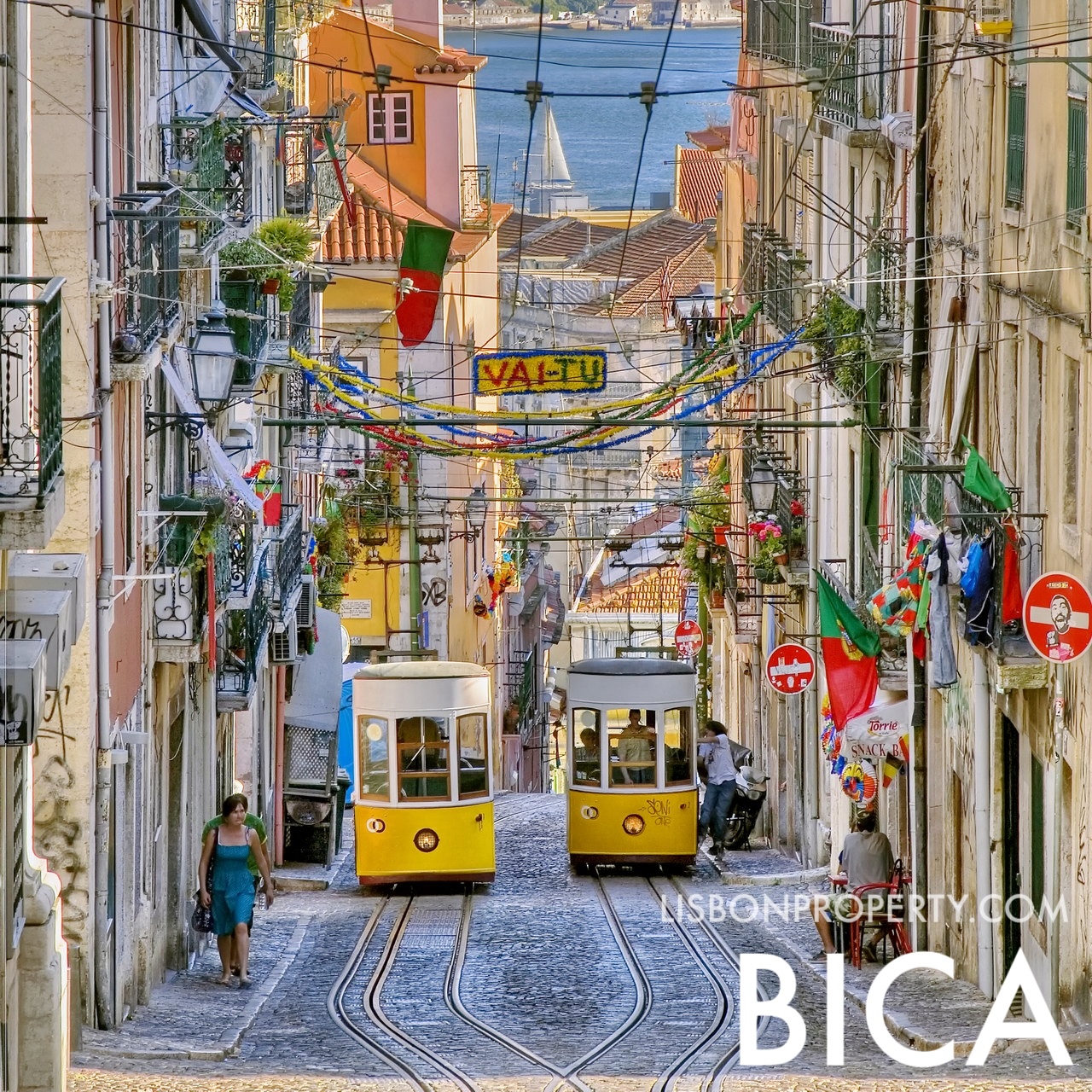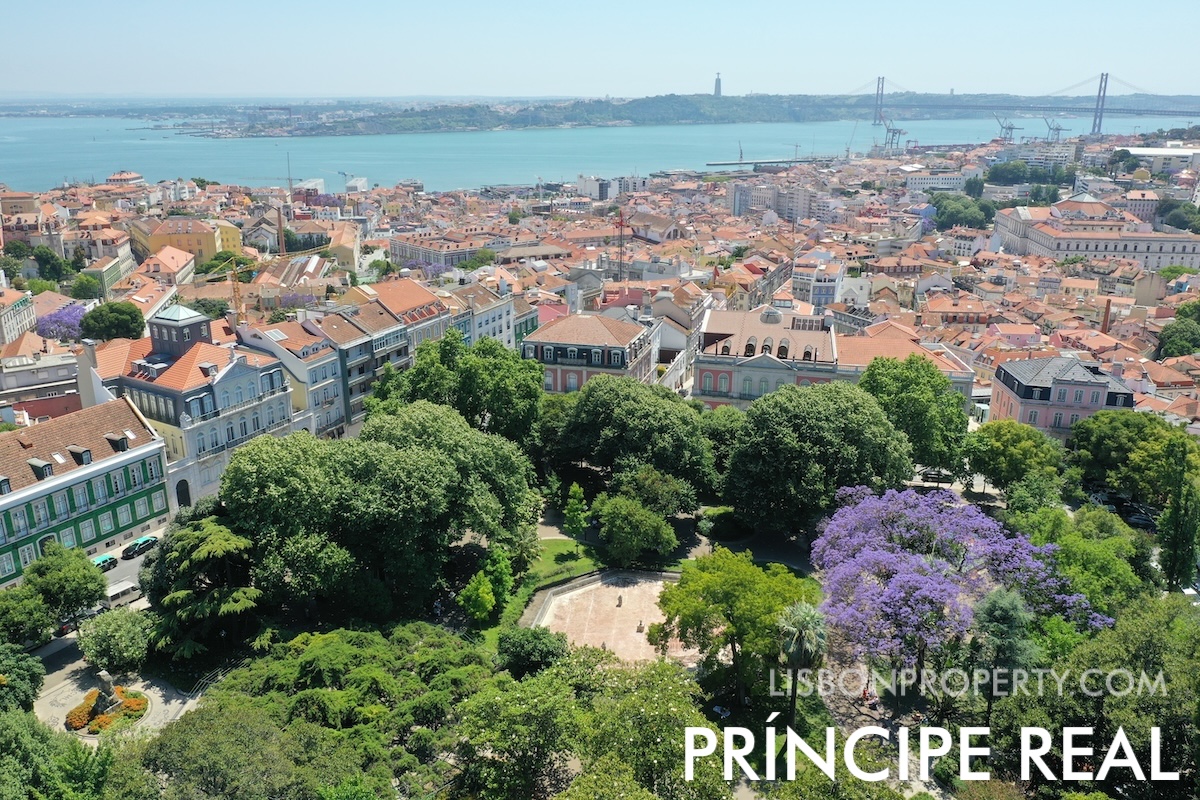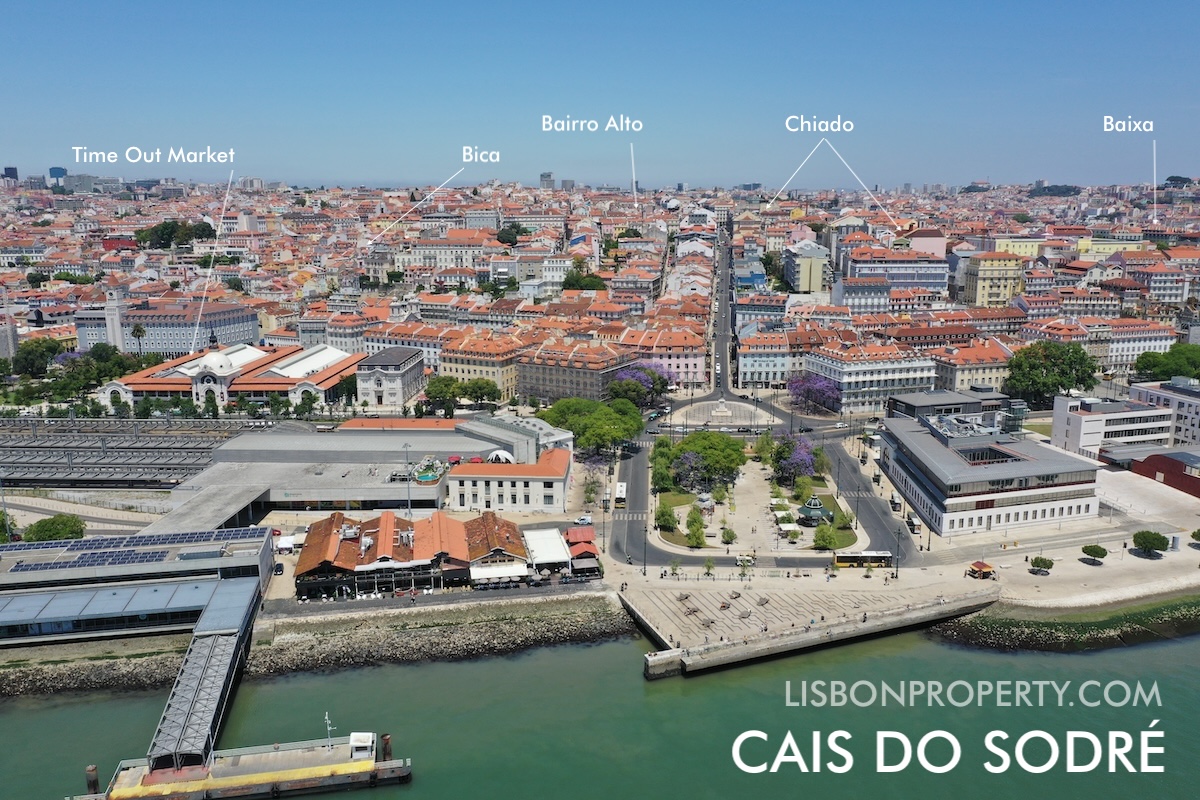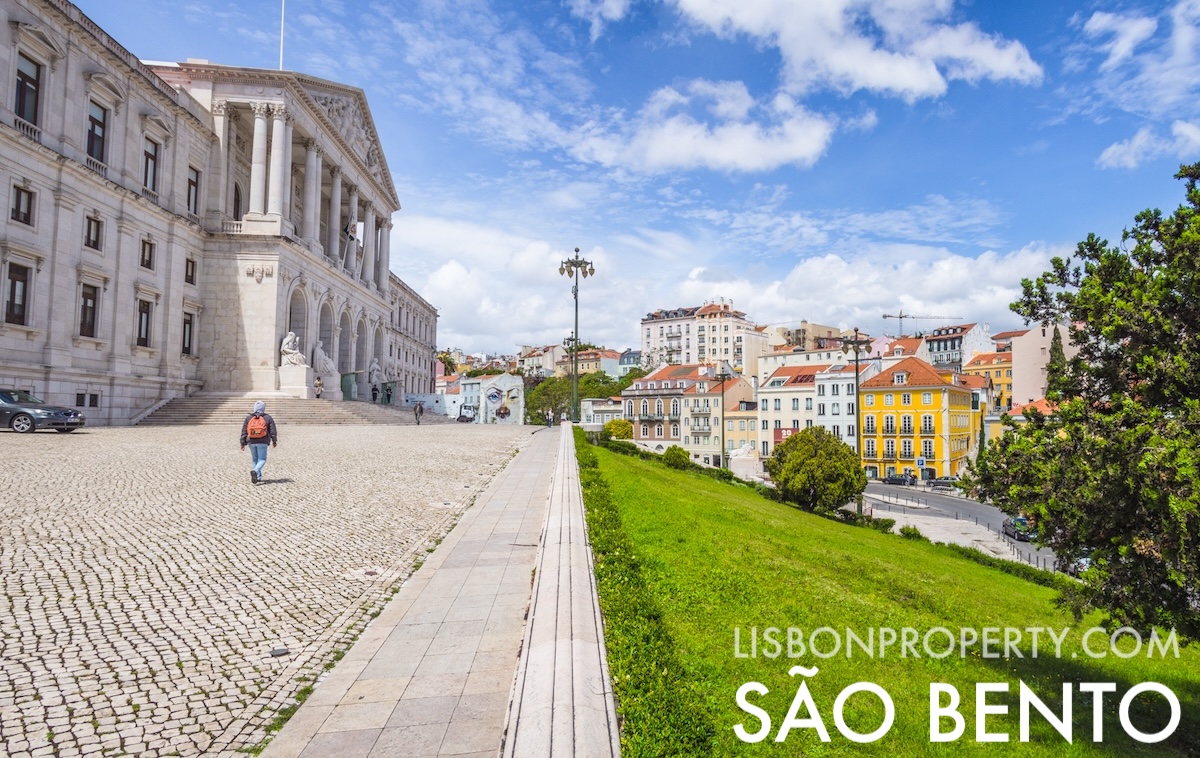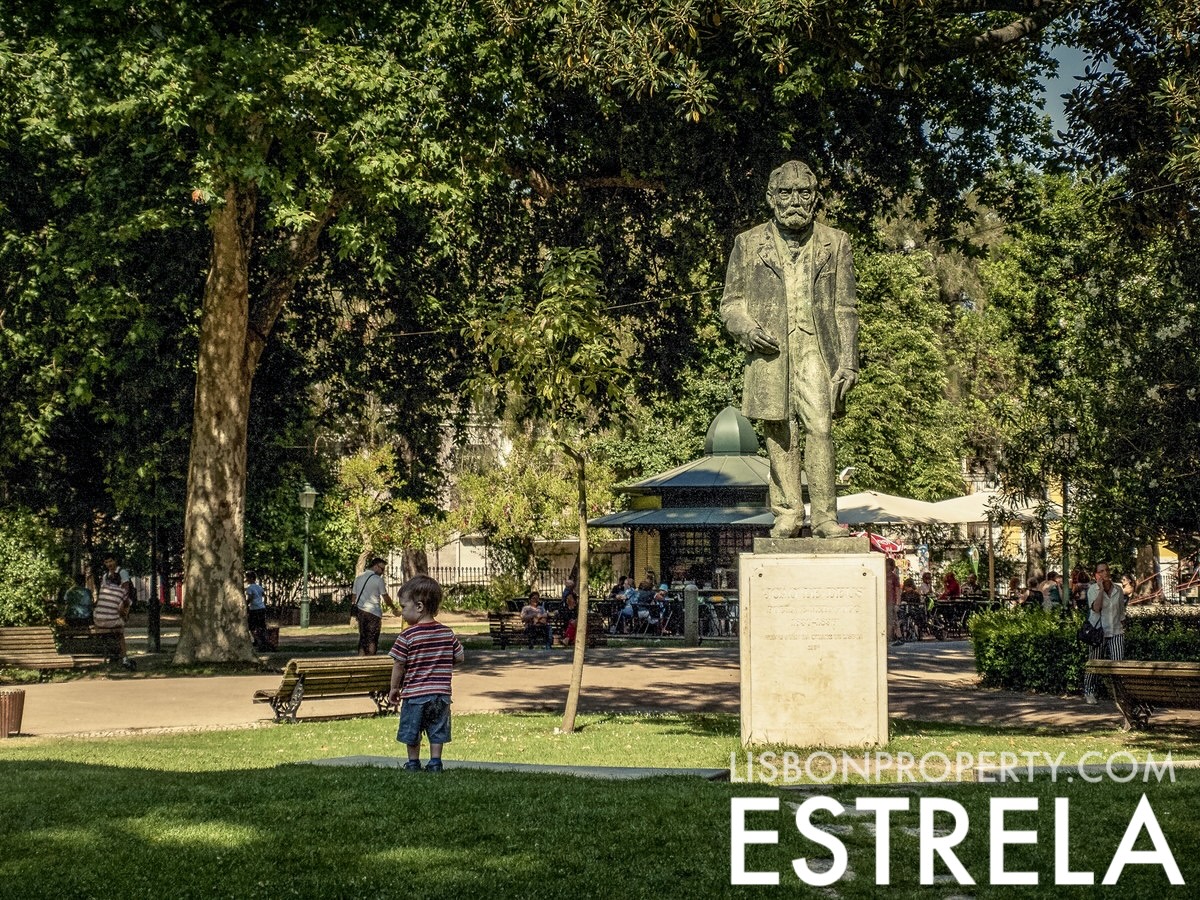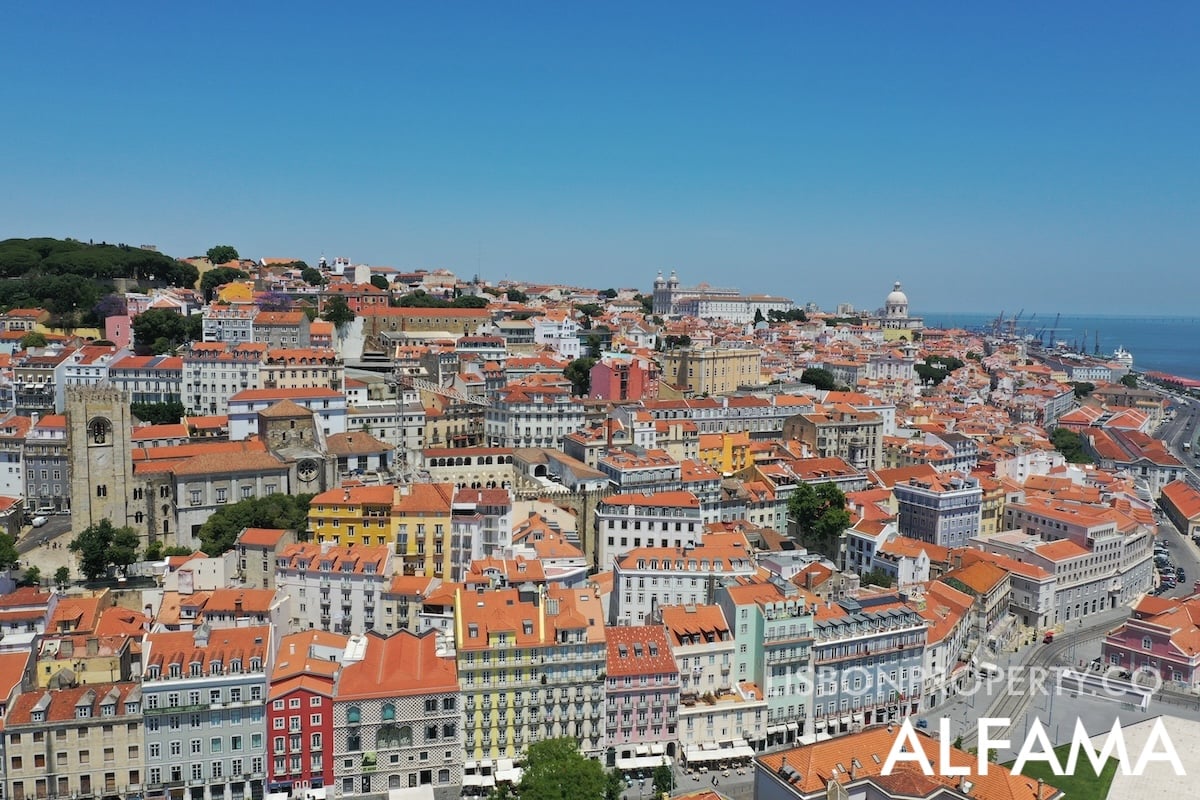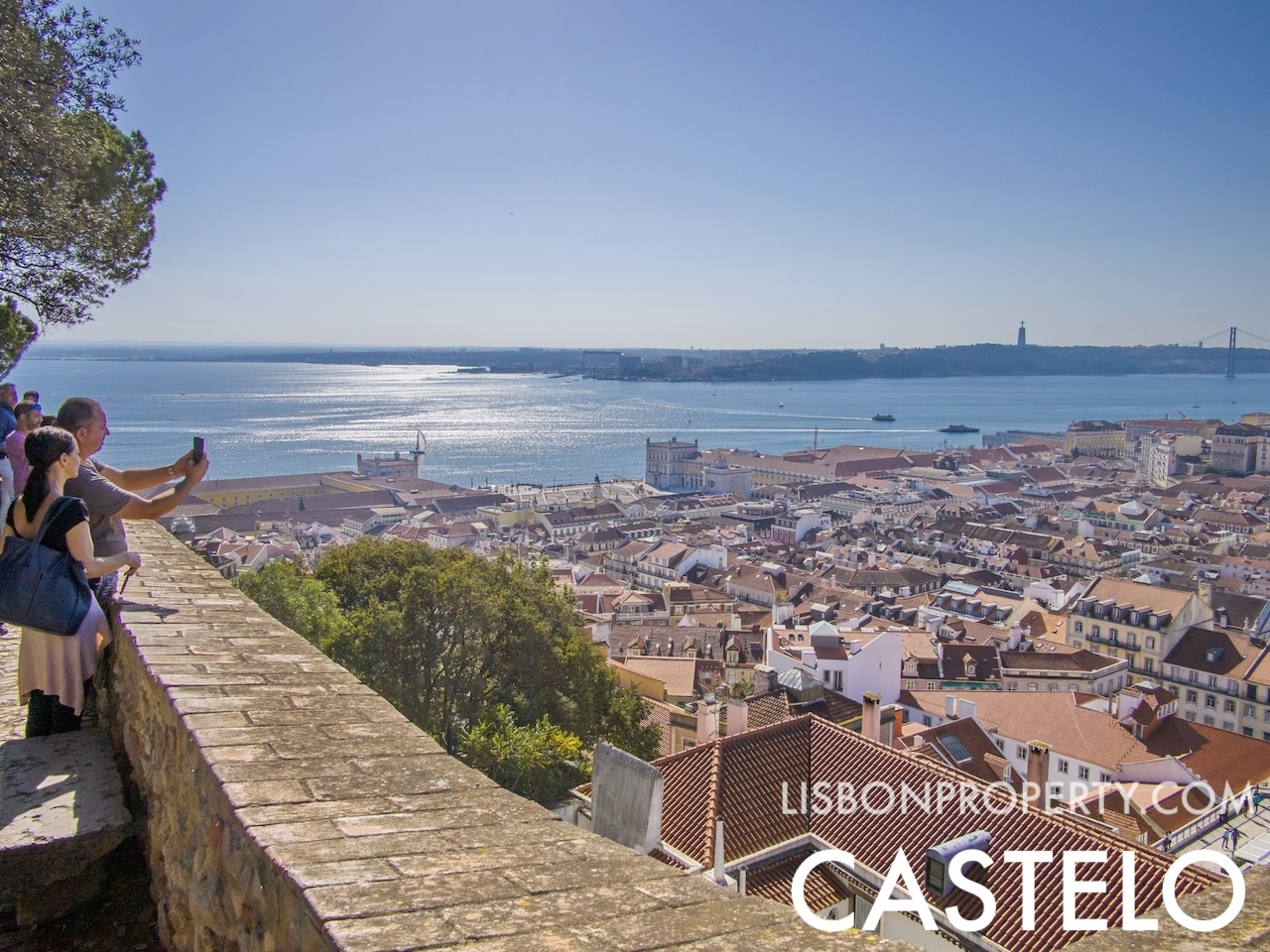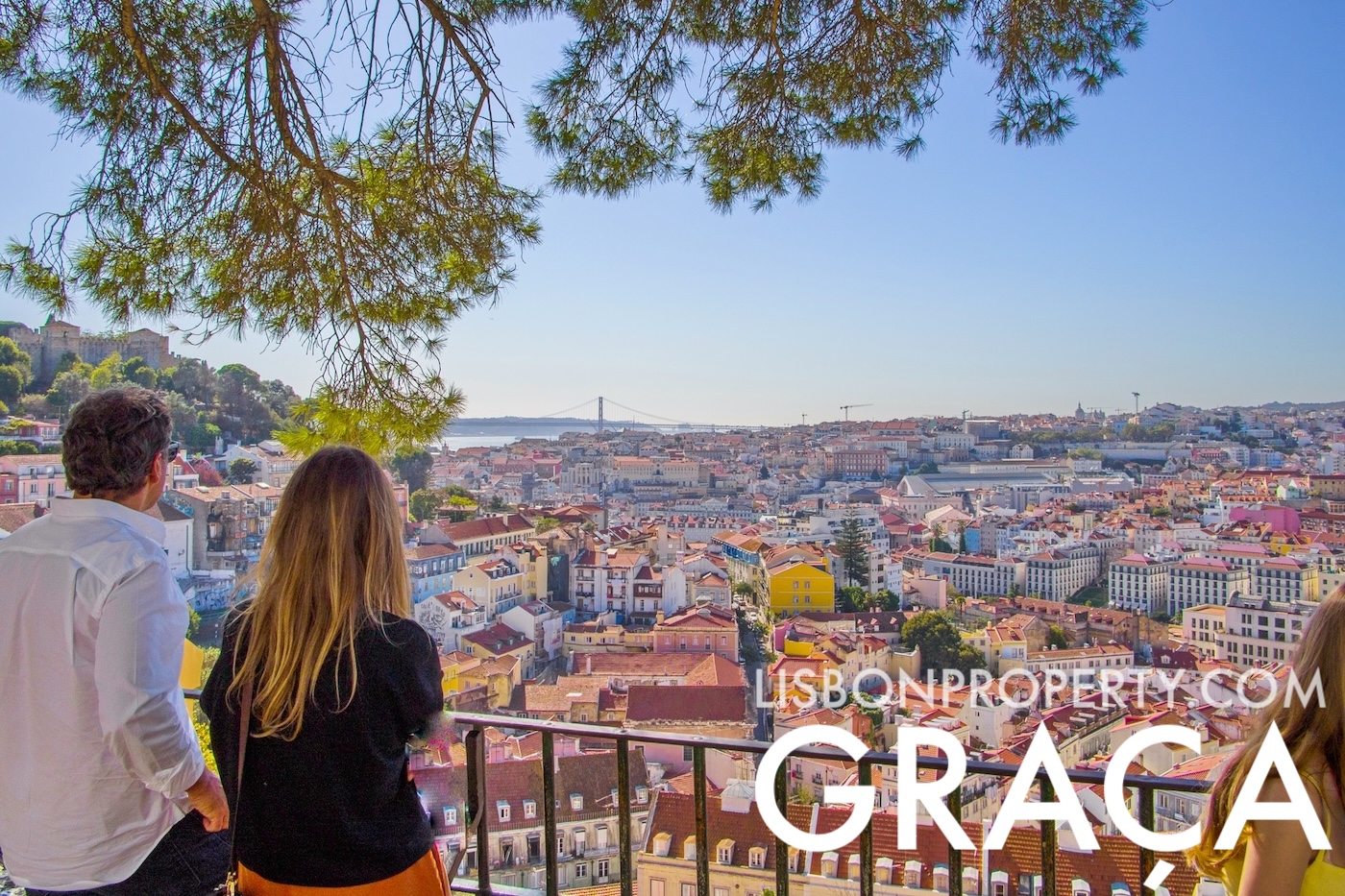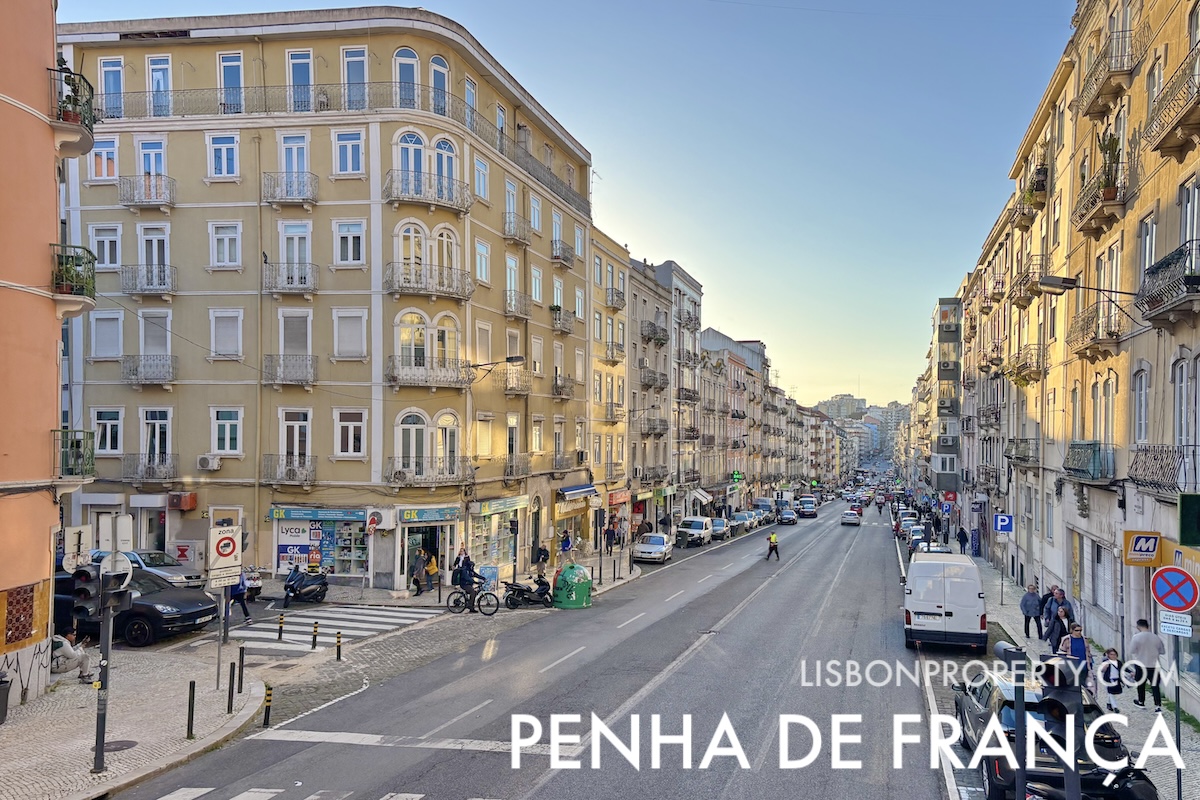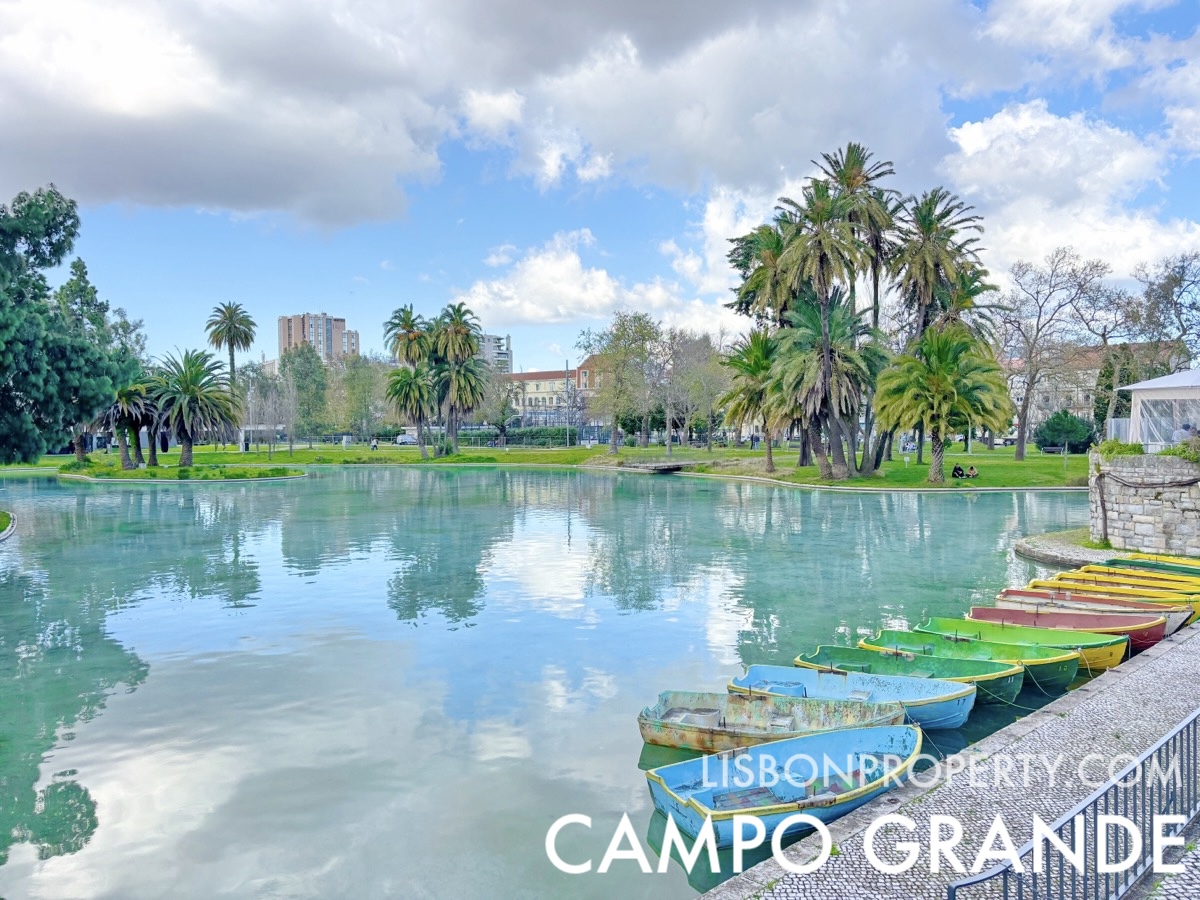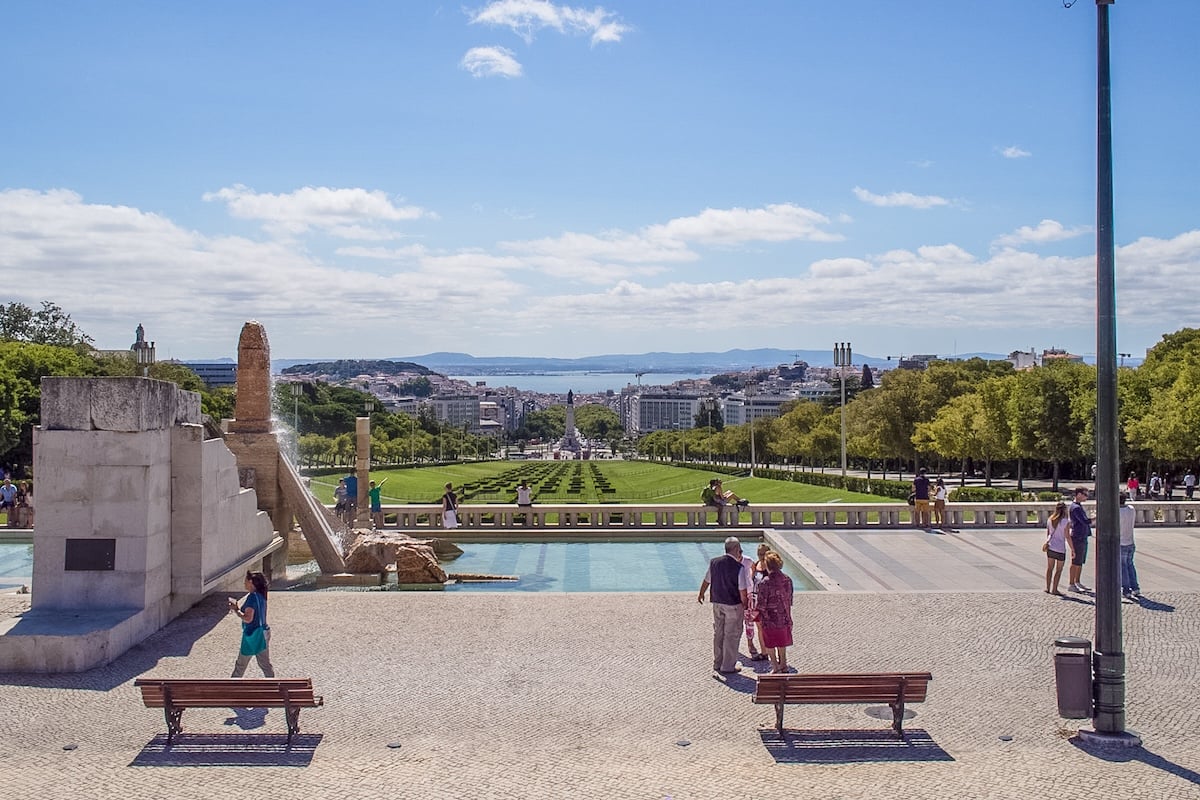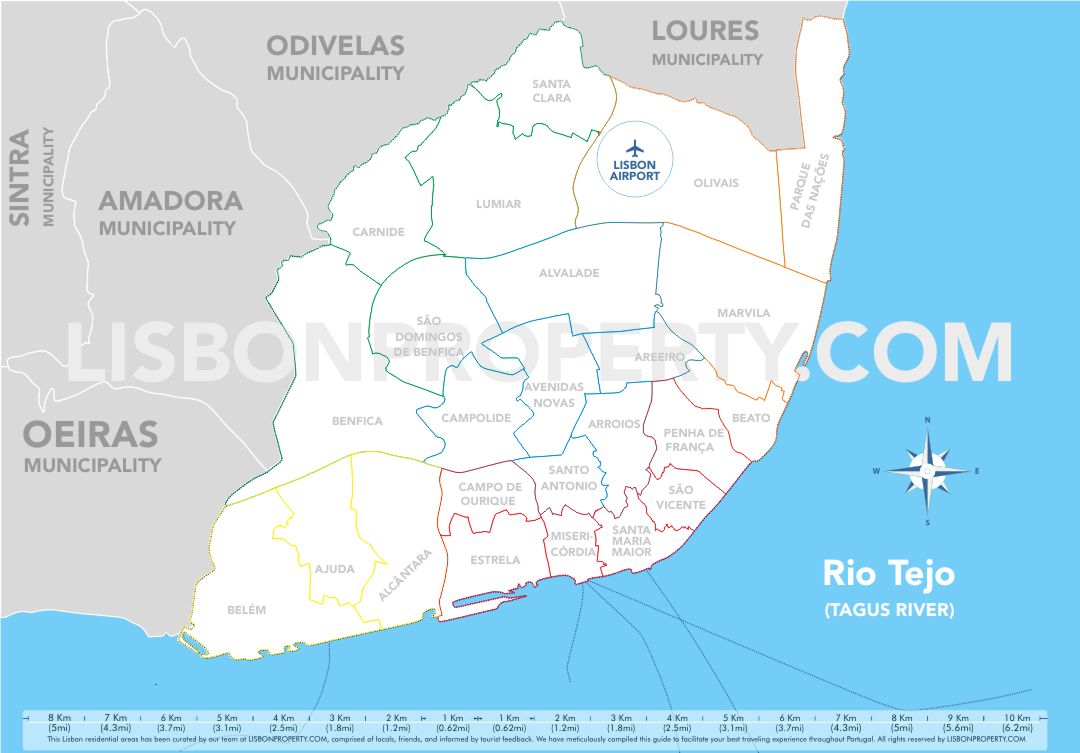
To enhance your understanding of Lisbon, we have divided the information into smaller, focused articles. Each article covers a specific parish and its neighborhoods in Lisbon, detailing aspects such as size, population, unique features, residential areas, tourist attractions, and other relevant information. This is especially useful for first-time visitors to Lisbon, as well as those considering moving to the city. Key information about laws and benefits, which are applicable to Lisbon and reflective of Portugal as a whole, can be found in the main article about Portugal.
Living in Lisbon
- Lisbon Properties for Sale – For living in Lisbon, follow the link to our properties in Lisbon page.
Lisbon • capital city of Portugal
Lisbon is the capital city of Portugal, (Lisboa in Portuguese), situated on the center western coast of Portugal, in the western portion of the Iberian Peninsula. It is mainland Europe’s westernmost capital city. 100.05 km2. 550 000 aproximatly population
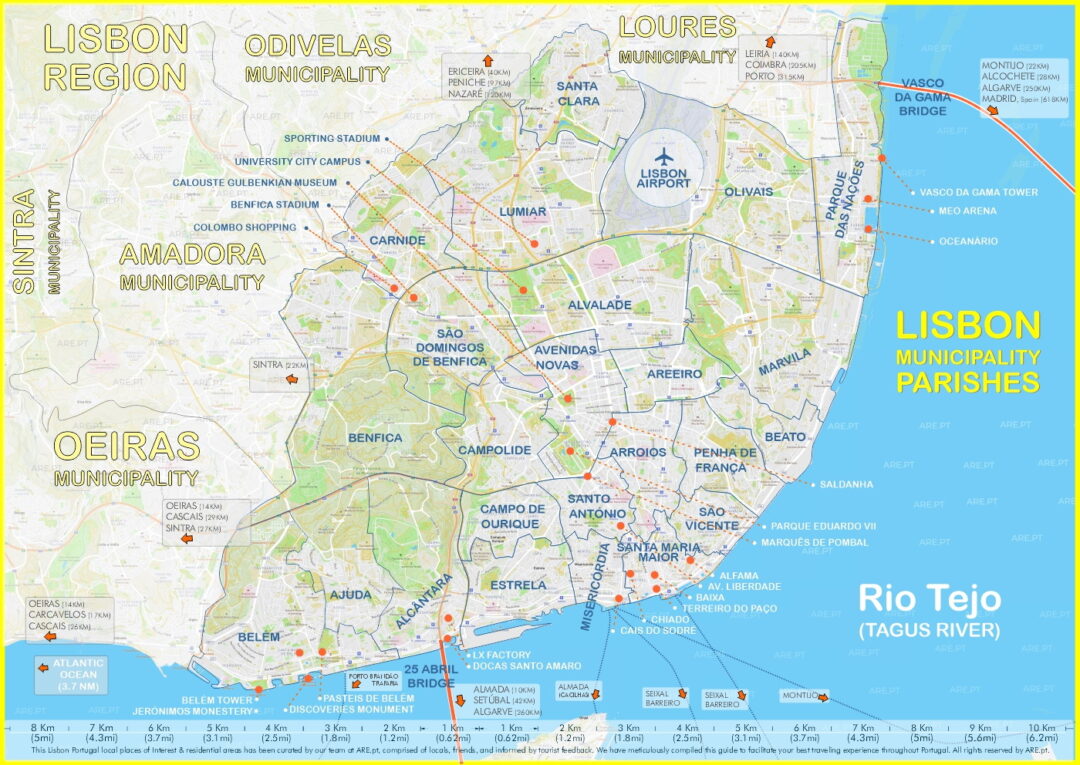
Lisbon has 24 parishes, grouped into 5 main areas: historic center, center, western, eastern, and northern areas
Understanding Lisbon area
Lisbon has 24 parishes, grouped into 5 main areas: historic center, center, western, eastern, and northern areas:
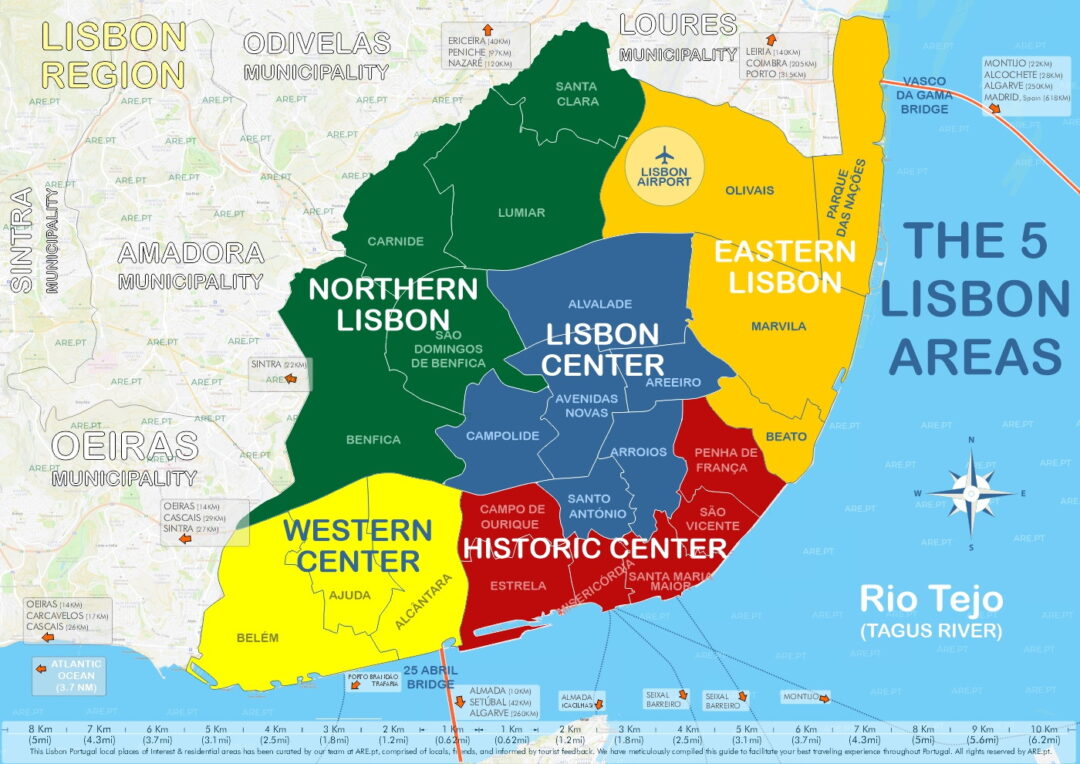
Lisbon is organized into five main areas, each with distinct characteristics. The Historic Center includes the city’s oldest landmarks and cultural sites, such as Baixa and Chiado. The West area, adjacent to the Atlantic coast, features modern developments like Belem. The Central region acts as Lisbon’s commercial hub, mixing residential, business, and retail spaces, including the luxury residential areas of Saldanha and Avenidas Novas. The Eastern part is marked by industrial zones and is experiencing significant urban renewal, exemplified by Parque das Nações and Braço de Prata. Lastly, the North is predominantly residential, noted for newer housing, expansive green spaces, and notable locations like Benfica, Telheiras, and football stadiums.
Parishes & Neighbourhoods in Lisbon Historic Center
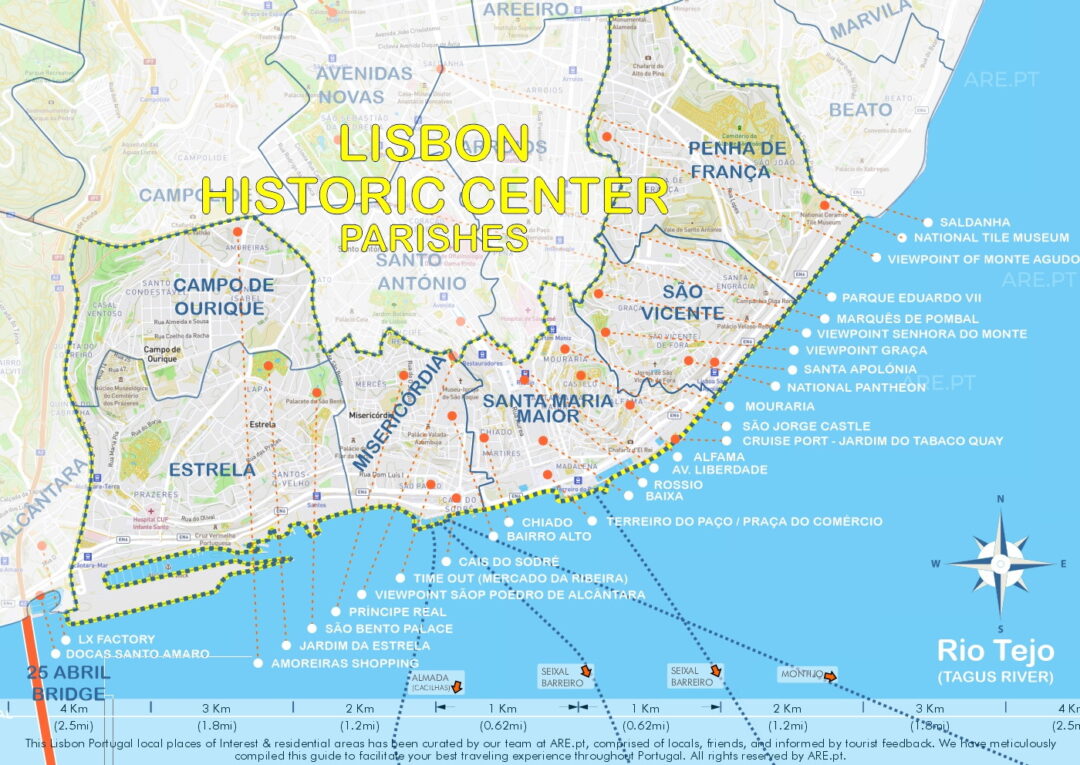
The Historic Center of Lisbon includes several parishes such as Estrela, Campo de Ourique, Misericordia, Santa Maria Maior, São Vicente, and Penha de França. This map highlights major attractions in these areas, showcasing the rich cultural and historical landmarks that define historic central Lisbon.
Lisbon Historic center
- Estrela: Cultural Districts (museums and cultural venues), Luxury Areas (upscale housing and amenities)
- Misericórdia: Tourist Hotspots (popular attractions), Cultural Districts (galleries and theaters), Nightlife Districts (bars and clubs), Culinary Districts (varied dining options)
- Santa Maria Maior: Tourist Hotspots (key tourist destinations), Cultural Districts (historic sites), Nightlife Districts (nighttime entertainment), Historic Residential Areas (older neighborhoods), Ethnic Enclaves (specifically Mouraria)
- Campo de Ourique: Mixed-Use Areas (commercial and residential spaces), Culinary Districts (diverse food offerings)
- São Vicente: Historic Residential Areas (historic homes), Religious Centers (churches and religious landmarks)
- Penha de França: Residential Areas (predominantly residential structures)
Parishes & Neighbourhoods in Central Lisbon
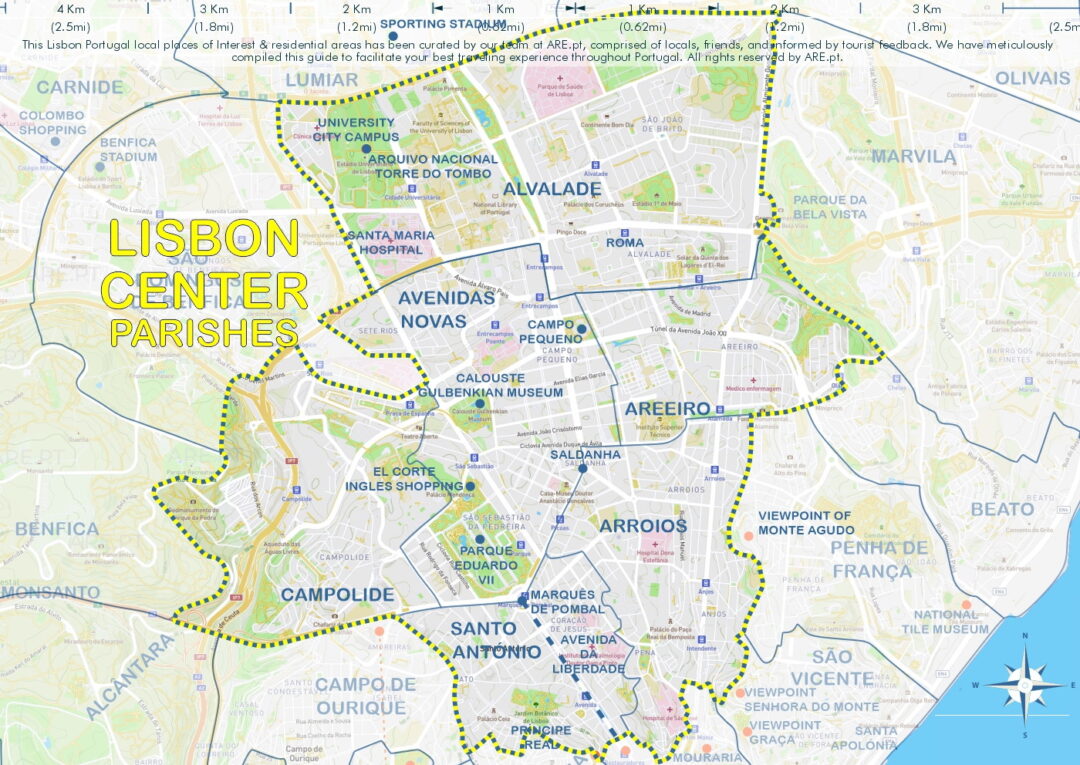
Central Lisbon is composed of several key parishes including Santo António, where Avenida da Liberdade, Lisbon’s most luxurious shopping area, is located. Other important parishes in this central region are Arroios, Campolide, Avenidas Novas, Areeiro, and Alvalade. These areas host a mix of residential neighborhoods, business districts, and retail spaces
Center of Lisbon
- Santo António: Educational Zones (educational institutions), Governmental Areas (government buildings), Luxury Areas (upscale housing and shopping)
- Arroios: Mixed-Use Areas (commercial and residential spaces), Ethnic Enclaves (diverse population)
- Campolide: Mixed-Use Areas (commercial and residential spaces)
- Avenidas Novas: Business Districts (corporate offices), Residential Areas (apartment complexes)
- Areeiro: Transportation Hubs (key transit intersections), Governmental Areas (presence of governmental buildings), Healthcare Districts (hospitals and clinics)
- Alvalade: Educational Zones (numerous schools and universities), Residential Areas (primarily residential structures)
Parishes & Neighbourhoods in Western Lisbon
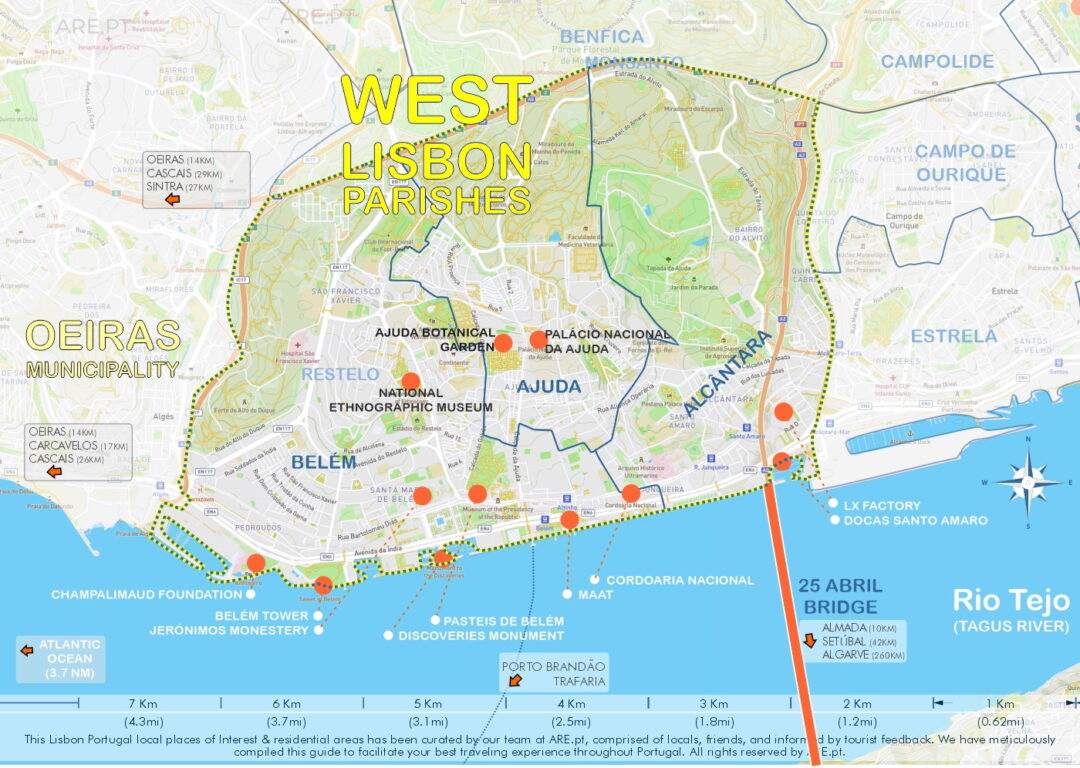
Belem, Ajuda, and Alcantara comprise the western area of Lisbon, known for major landmarks like Torre de Belem and Jeronimos Monastery. This area features the riverfront sidewalk along the Tagus River and the affluent Restelo residential area. Additional attractions include the MAAT (Museum of Art, Architecture, and Technology) and the Belem Cultural Center, blending historical sites with contemporary culture and upscale living.
Western Lisbon
- Belém: Tourist Hotspots (museums and historical landmarks), Recreational Areas (gardens and parks), Coastal Areas (adjacent to the Tagus River)
- Ajuda: Residential Areas, Tourist Hotspots (due to the presence of the Ajuda National Palace)
- Alcântara: Transportation Hubs (major railway and port connections), Coastal Areas (adjacent to the Tagus River), Mixed-Use Areas (commercial and residential spaces)
Parishes & Neighbourhoods in Eastern Lisbon
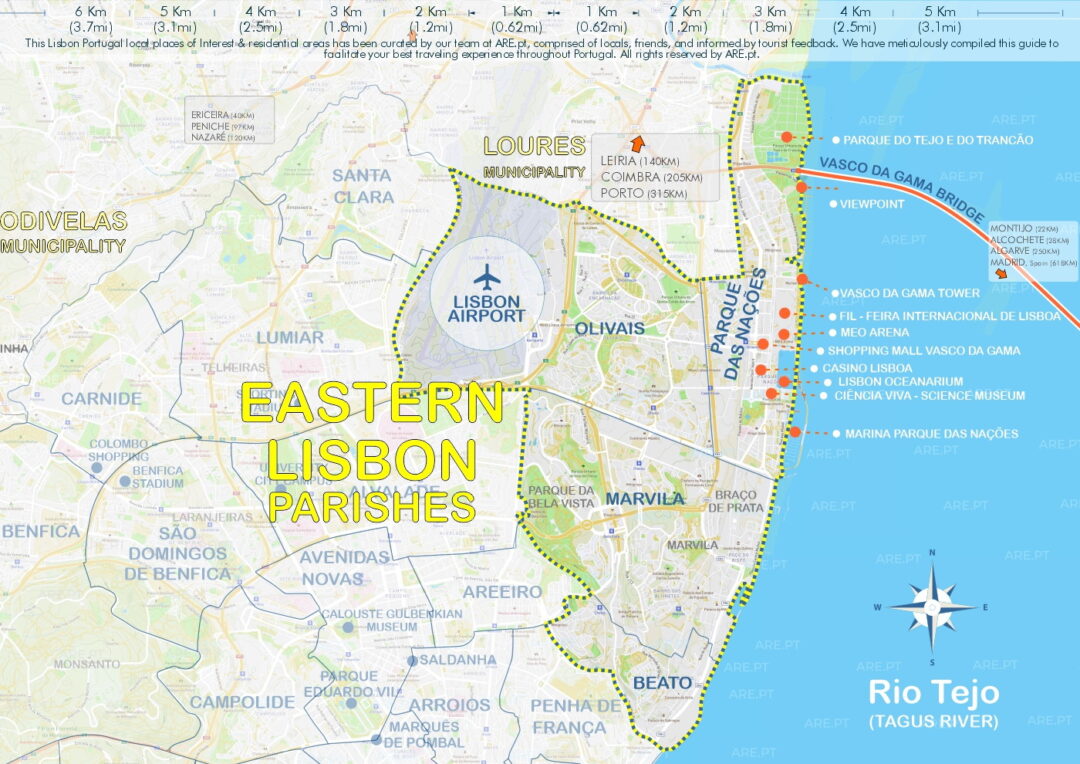
Eastern Lisbon includes the parishes of Olivais, which houses Lisbon’s main airport, and Parque das Nações, a modern area developed for Expo ’98 that has since evolved into a bustling hub of contemporary architecture, shopping, and entertainment. Additionally, the regions of Marvila and Beato are currently undergoing significant revitalization, transforming these historically industrial areas into trendy neighborhoods with new residential and commercial projects.
Eastern Lisbon
- Parque das Nações: Business Districts (corporate offices), Recreational Areas (parks and entertainment venues), Coastal Areas (adjacent to the Tagus River), Modern Residential Areas (newly developed housing)
- Beato: Industrial Zones (factories and warehouses), Redevelopment Areas (urban renewal projects)
- Marvila: Industrial Zones (industrial establishments), Redevelopment Areas (ongoing urban renewal)
- Olivais: Transportation Hubs (proximity to the airport), Residential Areas (primarily residential structures)
Parishes & Neighbourhoods in Northern Lisbon
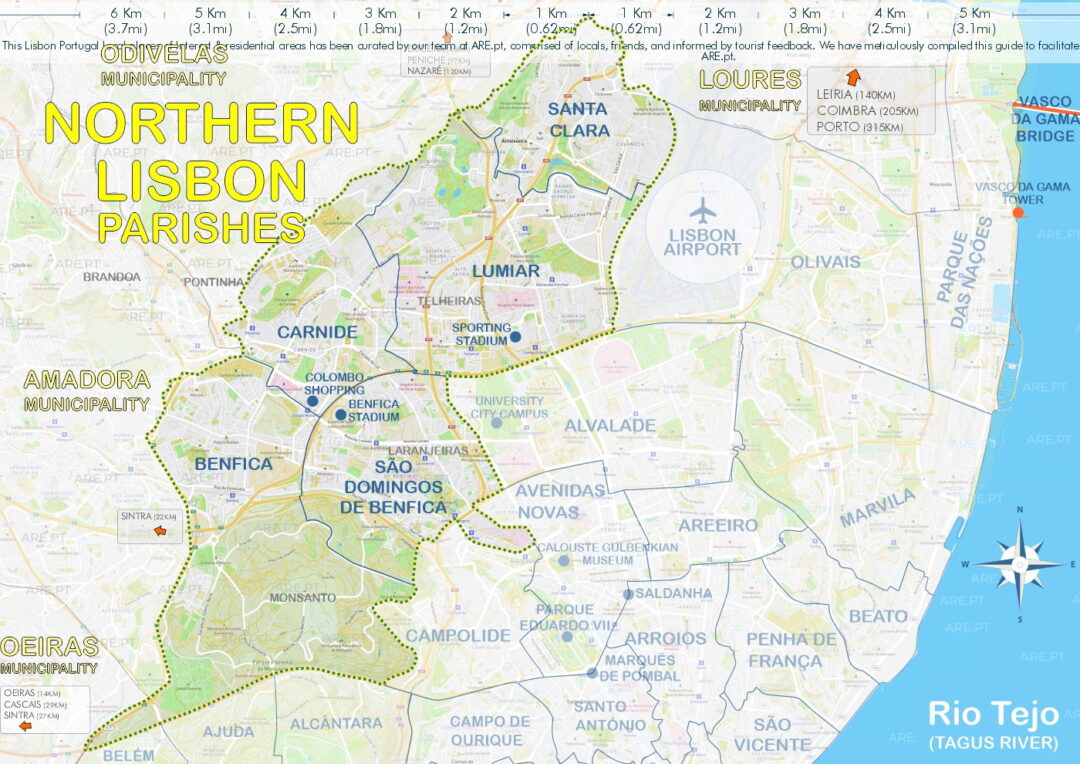
Northern Lisbon, encompassing the parishes of Benfica, São Domingos de Benfica, Carnide, Lumiar, and Santa Clara, is predominantly residential, merging historical charm with modern amenities. Key attractions in this area include the major football stadiums in Benfica and sporting arenas, the extensive Colombo Shopping Center, and the vast green spaces of Monsanto Park
Northern Lisbon
- Benfica: Modern Residential Areas (newly developed housing), Residential Areas (varied housing structures)
- Carnide: Suburban Areas (low-density residential), Religious Centers (churches)
- Lumiar: Educational Zones (schools and educational facilities), Recreational Areas (parks)
- Santa Clara: Suburban Areas (low-density residential)
- São Domingos de Benfica: Suburban Areas (residential outskirts), Healthcare Districts (hospitals and clinics)
Brief introduction to Lisbon’s main touristic areas
(Each of these areas is explained in more detail in the expanded articles below.)
In Lisbon city you’ll discover a tapestry of neighborhoods that collectively define the city’s unique character and charm. From the grandeur of Avenida da Liberdade to the historic alleys of Alfama, each district tells its own story and offers a rich tapestry of experiences for residents and visitors alike.
- Avenida da Liberdade stands as an elegant boulevard, lined with luxury boutiques, upscale hotels, and charming cafes. It epitomizes the city’s cosmopolitan allure and serves as a hub for high-end shopping and cultural events.
- Baixa, Lisbon’s downtown area, with bustling streets and vibrant squares. This historic district boasts grand squares like Praça do Comércio, impressive architecture, and a thriving commercial scene.
- Chiado, known for its elegant ambiance and artistic heritage, offers a blend of traditional and contemporary attractions. It features trendy boutiques, bookstores, and iconic cultural institutions like the Café A Brasileira, a famous meeting place for artists and intellectuals.
- Bairro Alto, the bohemian enclave of beckons with its lively atmosphere, narrow streets, and vibrant nightlife. It’s a place where trendy bars, traditional fado houses, and eclectic shops come alive after dark.
- Alfama, a taste of Lisbon’s authenticity oldest neighborhood. Lose yourself in its maze-like streets, adorned with colorful houses, traditional Fado music venues, and stunning viewpoints overlooking the city.
- Príncipe Real entices with its upscale shops, art galleries, and beautiful gardens, while São Bento showcases its historic buildings, including the Portuguese Parliament.
- Estrela, a tranquil escape with its lush park, Estrela Basilica, and charming residential areas.
- Campo de Ourique, a residential neighborhood, boasts a vibrant market and a mix of traditional and modern establishments.
- Graça or Castelo with the medieval atmosphere and panoramic views from their hilltop viewpoints.
- Arroios, with its multicultural vibe, blends different cultures and cuisines into a lively melting pot.
- Avenidas Novas characterized by its wide avenues, upscale residences, and renowned cultural venues.
- Parque das Nações, once an industrial area, has transformed into a modern district featuring the iconic Vasco da Gama Tower, shopping centers, and the Lisbon Oceanarium.
- Penha de França, Beato, Marvila, Alcântara, Algés, Belém, and Ajuda each bring their unique flavor to Lisbon’s mosaic. These districts offer a blend of historical landmarks, waterfront charm, and cultural attractions, such as the famous Belém Tower, Jerónimos Monastery, and the beautiful gardens of Ajuda National Palace.
- Lisbon’s neighborhoods form a captivating tapestry that intertwines history, culture, and contemporary living. Each district has its own distinct character, creating a cityscape that is as diverse as it is enchanting.
How to get to Lisbon
By plane
The primary airport in Lisbon is the Humberto Delgado Airport, also known as Lisbon Airport. It’s well-connected internationally to all continents, european major cities, and domestically to Porto in the north and Faro in the south of Portugal. From Lisbon airport, you can take taxis, buses, or the metro to get to different parts of the city. Metro leaves from Lisbon airport to the eastern side of the city, and city center in Avenidas Novas Saldanha area. It connects with all metro lines to take to any part of Lisbon.
By car or bus
Major cities in Portugal have regular buses (several per day) to Lisbon
Driving from southern Portugal
Highway A2 – Autoestrada do Sul: Coming from the southern regions of Portugal, the A2 highway is your main route. It connects Lisbon with the Algarve, passing through regions like Setúbal and the Alentejo
Bridge 25 de Abril: This iconic suspension bridge connects the city of Lisbon, on the northern bank of the Tagus River, with the municipality of Almada on the southern bank. If you’re coming from the south of Portugal or from regions like Alentejo and Algarve, this bridge is a common route into Lisbon.
Bridge Vasco da Gama: Another major bridge in Lisbon, the Vasco da Gama Bridge, is one of the longest bridges in Europe. It links the northern side of Lisbon with the Setúbal Peninsula and Alcochete. This is an alternative route if you’re traveling from the south, especially if you want to avoid the often busier 25 de Abril Bridge.
Driving from nothern Portugal
Highway A1 from the northern part of Portugal: If you’re driving from the north, such as from Porto or Coimbra, you’ll likely use the A1 highway. This motorway is the primary north-south axis in the country, leading directly to Lisbon.
Highway A5 – Autoestrada da Costa do Estoril: This highway connects Lisbon to Cascais, running along the coast of the Estoril. It’s particularly useful if you’re coming from the western part of the Lisbon metropolitan area, including the popular tourist destinations of Cascais and Estoril. The A5 starts in Lisbon, near the Monsanto area, and it’s a direct route for those traveling from the coastal areas to the city.
Highway A8 – Autoestrada do Oeste: The A8 is the main route if you’re coming from the northwest, particularly from regions like Leiria or the western part of Central Portugal. It connects Lisbon to the town of Leiria and extends further north. This highway is a key link for those traveling to Lisbon from the central and northern coastal areas of Portugal.
By train
The most practical ways of traveling to Lisbon by train are by Comboios de Portugal (CP), the national railway company.
From Portugal, you can take the Alfa Pendular (AP) and Intercidades (IC) Trains: These are high-speed and express trains connecting major cities in Portugal to Lisbon. The Alfa Pendular is the fastest option, linking cities like Porto, Coimbra, and Faro to Lisbon. The Intercidades service also connects these and other cities, though with more stops and a slightly longer journey time.
Getting to Lisbon from Spain by train: Lusitania Train Hotel, an overnight train service connecting Madrid in Spain to Lisbon, offering sleeping accommodations.
Getting to Lisbon from France by train: Sud Expresso, an overnight train that connects Lisbon with Hendaye in France, near the Spanish border. From Hendaye, you can connect to the French railway network.
Arriving in the Lisbon train Stations:
- Lisboa Santa Apolónia: Is Lisbon’s oldest railway station and a primary terminal for international and long-distance trains.
- Lisboa Oriente: A modern station located in the Parque das Nações, it serves both domestic (including Alfa Pendular and Intercidades) and international trains. It’s also well integrated with local public transport, including buses and the metro.
- Lisboa Entrecampos: caters to Alfa Pendular, Intercidades, and regional trains. It serves as a key hub for both long-distance and regional connections within Portugal. Entrecampos is well integrated with Lisbon’s metro network, providing easy access to the Yellow Line.
- Rossio train station: located in the Rossio Square, is a key railway hub known for its remarkable 19th-century Romantic architecture. Its striking façade, characterized by horseshoe-shaped arches and intricate stone work, makes it a notable landmark in the city. The station primarily serves regional trains, particularly those connecting Lisbon to the town of Sintra, a popular tourist destination. Its central location makes it a convenient starting point for exploring the historic and vibrant areas of downtown Lisbon.
By boat
Arriving in Lisbon by boat thru Tagus River. Sailboats and motorboats can dock at marinas like Marina Parque das Nações and Doca de Belém.. For cruise ships, the Lisbon Cruise Port, with its main terminals at Alcântara and Santa Apolónia, serves as the primary docking point. These locations are walkable to city center and city transport system.
Moving inside Lisbon
- Metro: The Lisbon Metro is a quick and efficient way to travel around the city. It covers many key areas and is especially useful for longer distances or avoiding traffic. The metro system is clean, relatively inexpensive, and easy to navigate with clear signage and maps.
- Buses and Trams: The bus network in Lisbon is extensive, reaching areas that are not covered by the metro. Buses are frequent and fairly reliable. Additionally, the iconic trams of Lisbon, particularly Tram 28, are not only a means of transport but also a tourist attraction, offering a scenic route through the city’s historic areas.
- Trains: For travel to suburbs or nearby towns like Sintra or Cascais, trains are a good option. The train stations are well-connected to the metro and bus systems, making it easy to transition from city travel to longer journeys.
- Taxis and Ride-Sharing: Taxis are readily available throughout Lisbon. Ride-sharing services like Uber also operate in the city, offering an alternative to traditional taxis. Both options provide door-to-door service and can be more convenient when public transport doesn’t suit your needs or schedule.
- Walking: Lisbon is a very walkable city, especially in the central areas. Walking can be a pleasant way to explore, but be prepared for hilly terrain in some parts of the city.
- Bicycles and Scooters: For the more adventurous, renting a bicycle or an electric scooter can be a fun way to get around. This is especially popular in flatter areas and along the river.
- Ferries: To cross the Tagus River, ferries are available. They offer a quick connection between Lisbon and cities on the other side of the river, such as Almada, and provide a unique view of the city from the water.
Lisbon hills main attractions
Lisbon city is spread across 7 hills and valleys, and it’s bordered by the Tagus River on south to east side, which flows along the southern edges of the city before emptying west into the Atlantic Ocean.
- Colina de São Jorge (Castle Hill): This is the highest hill (although technically Colina da Graça, contiguous to it, is higher but often overlooked). It’s the site of the current São Jorge Castle and is believed to be where Lisbon was first settled. Remains of a Roman village were found here, as well as the site of the former Arab alcácer. The castle from the time of the Reconquista still exists today. Geographically, it covers the Mouraria, Castelo, and part of Alfama neighborhoods.
- Colina de São Vicente: Home to the Alfama neighborhood and the São Vicente de Fora Monastery.
- Colina de Sant’Ana: Previously the site of the Monastery of the Dominican Nuns of Nossa Senhora da Anunciada, now the Largo da Anunciada. This hill is located to the west of the São Jorge Castle.
- Colina de Santo André: Known for its strategic importance in history, especially during the siege of Lisbon in 1147 led by D. Afonso Henriques. Post the earthquake of 1755, the area became a preferred residential location for noble families.
- Colina das Chagas: Named after a church built by sailors of the India route in honor of the wounds of Christ. Today, it encompasses the area around Largo do Carmo.
- Colina de Santa Catarina: Extending from Camões Square to Calçada do Combro.
- Colina de São Roque is one of the seven hills of Lisbon, primarily known for hosting the Bairro Alto neighborhood, a historic area famous for its vibrant nightlife, traditional Fado houses, and bohemian atmosphere. The hill is also home to the Miradouro de São Pedro de Alcântara, a popular viewpoint offering panoramic views of Lisbon, including the iconic São Jorge Castle.
Quick facts about Lisbon
- Lisbon experienced a catastrophic earthquake in 1755. The Lisbon Earthquake, which occurred on November 1, 1755, is one of the most significant and devastating earthquakes in European history. It is estimated to have been around magnitude 8.5–9.0, and it resulted in widespread destruction across Lisbon and the surrounding areas.
- Baixa Pombalina, commonly known as Baixa, is a district in central Lisbon that was extensively rebuilt following the catastrophic 1755 Lisbon earthquake. Under the leadership of the Marquis of Pombal, the then Prime Minister of Portugal, Baixa was reconstructed with pioneering urban planning techniques.
- Lisbon is recognized as an alpha-level global city: according to the Globalization and World Cities Research Network (GaWC) of Loughborough University in the UK. This classification highlights Lisbon’s significance in various sectors including finance, commerce, fashion, media, entertainment, arts, international trade, education, and tourism.
- The Bertrand Bookstore (Livraria Bertrand) in Lisbon, Portugal, is recognized by the Guinness World Records as the world’s oldest operating bookstore. Established in 1732, it has been open for nearly three centuries.


